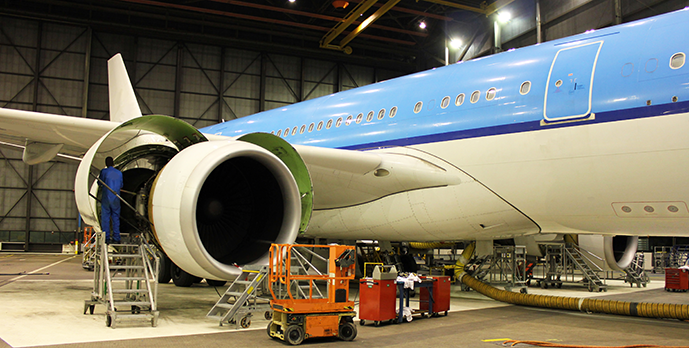What is MSG-3?
It is system whereby we develop the maintenance Program for virtually “All” Large Aircraft.
Some of the major advantages of MSG-3
MSG-3 is a Top-down process, which enables a step by step systematic analysis. (What does this mean?)
MSG-3 delivers lower maintenance costs with typical savings ranging from 15% to 25% for the same aircraft type on conversion from MSG-2 to MSG-3.
MSG-3 typically delivers a substantial cost reduction in hard time component removal and replacement.
MSG-3 results in fewer maintenance tasks but Note the importance of “Managing Competencies”.
Some MSG-3 tasks are carried out for economic reasons, while others are carried out to deliver an improved safety level. (Discuss – Reasons for Maintenance)
Based on an effective and efficient model MSG-3 has continued to be developed to include as a core consideration CPCP (Corrosion Prevention and Control Program), Structural Significant Item Inspection, and Enhanced Zonal Analysis, which introduced the term EWIS Electrical Wiring Interconnect Systems, and Lightning/High Intensity Radiated Fields.
MSG -3 introduced Three Control Process.
Hard Time limit: Maximum interval for performing maintenance tasks on a part or unit. Such intervals apply to overhaul, but also to the total life of the part or unit.
On-Condition: Repetitive inspections or tests to determine the condition of units or systems, comprising servicing, inspecting, testing, calibrating and replacement.
Zonal Inspection Program.
The MSG 3 process applies a function, failure, failure effects and causes analysis on each element using a Failure Modes Effect Analysis (FMEA). Potential damage is considered possible from accident, environment or fatigue.
Working Groups consider Structure, Systems, Subsystems, Engines, and Zonal with the work being performed by the Maintenance Review Board (MRB). The output of the MRB is known as the Maintenance Review Board Report (MRBR).
The main output features of the MSG-3 process includes On Condition / Hard Time and a very important and much miss understood process called the Zonal Inspection Program ZIP.
Regulatory Standards and Requirements for Inspection
145.A.25 Facility requirements The organisation shall ensure that:
Lighting is such as to ensure each inspection and maintenance task can be carried out in an effective manner.
Noise shall not distract personnel from carrying out inspection tasks. Where it is impractical to control the noise source, such personnel are provided with the necessary personal equipment to stop excessive noise causing distraction during inspection tasks.
How good are your Corrosion Control assessment and Maintenance Procedures?
It is important to ensure we take all necessary precautions to minimise the possibility of any contamination which can lead to corrosion.
The work area, tooling and equipment should be clean of any foreign material for example grit or dirt or any other potential contaminates.
Never use a graphite pencil on aircraft metallic parts or skin – Graphite is cathodic to all structural metals and will generate galvanic corrosion in the presence of moisture.
Workwear and footwear should be clean and free of contaminates.
In particular Footwear may trap debris.
Overshoes should be worn were appropriate and particular care taken before walking or working on metal surfaces such as wings, stabilizers, fuel tanks, etc.
Never abrade or scratch any surface unless it is an authorized procedure.
If surfaces are accidentally scratched, the damage should be assessed and action taken to remove the scratch and treat the area.
Coated metal surfaces should not be polished for aesthetic purposes. Buffing would remove the protective coating and a brightly polished surface is normally not as corrosion resistant as a non-polished surface unless it is protected by wax, paint, etc. (But Note that – A bare skin sheet polished to a mirror finish is more resistant than a bare mill finished sheet when both are given regular maintenance.)
Protect surrounding areas when welding, grinding, drilling, etc., to prevent contaminating them with residue from these operations.
In those areas where protective covering cannot be used, action should be taken to remove the residue by cleaning.
Severely corroded screws, bolts, and washers should be replaced.
When a protective coating, such as a cadmium plating on bolts, screws, etc., is damaged, immediate action should be taken to apply an appropriate protective finish to prevent additional corrosion damage.
When active corrosion is visually apparent, a positive inspection and rework program is necessary to prevent any further deterioration of the structure.
In general, any rework would involve the cleaning and stripping of all finish from the corroded area, the removal of corrosion products, and restoration of surface protective film.
Repair of corrosion damage includes removal of all corrosion and corrosion products.
When the corrosion damage exceeds the damage limits set by the aircraft manufacturer in the structural repair manual, it is necessary to contact the aircraft manufacturer for rework limits and procedures.
Sofema Aviation Services provides more than 300 EASA Compliant Regulatory and vocational short courses for details please see www.sassofia.com or email office@sassofia.com
Tags:
EASA Aircraft Inspector, Maintenance, MSG-3, Regulatory Standards




